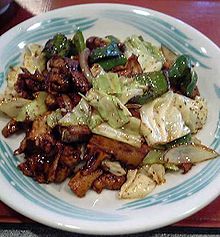- Twice cooked pork
-
Twice cooked pork (回鍋肉, pinyin: Huí Guō Ròu; literally "meat that has been returned to the pot"; also called double cooked pork), along with Mapo Dofu (麻婆豆腐), hot pot (火鍋) and Kung Pao chicken (官保雞丁), is a well-known Sichuan-style Chinese dish. The process of cooking twice cooked pork involves first boiling belly pork steak chunks with slices of ginger and salt, then after being cut into thin slices, the pork is returned to a wok and shallow fried in hot oil. The most common vegetables to accompany the pork in twice cooked pork are cabbage and peppers or leeks.
History
The Sichuan people are said to have a tradition of enjoying a feast every 1st and 15th of lunar months, with this dish as the main course. The simplest way of preparing this dish is to cook the meat by itself till it is done, then fry it along with the other ingredients; however, an alternative method involves frying the meat by itself till cooked, then frying the vegetables separately for a while, and finally frying everything together.[1]
References
- ^ "四川特色菜回锅肉". http://www.meiweizhongguo.com/caipu/chuancai/627.shtml. Retrieved January 25, 2010.
Sichuan cuisine Ants climbing a tree · Dan dan noodles · Doubanjiang · Fuqi feipian · Guaiwei · Guoba · Hot and sour soup · Hot pot · Kung Pao chicken · Mala sauce · Mapo doufu · Pao cai · Shuizhu · Sichuan pepper · Suanla chaoshou · Tuotuorou · Twice cooked pork · Wonton · Wuliangye Yibin · Yuxiang · Zha cai · Zhangcha duckSichuan topics General History NationsBa & Shu · Chengjia · Shu Han · Cheng Han · Western Shu · Former Shu · Later Shu · Great Shu · Great Xia · Great XiEventsSichuan-Mongol War · Huguang Filling Sichuan · Railway Protection Movement · Home Front PeriodGeography Cities • Sichuan Basin • Chengdu Plain • Regions (West • East • North • South) • Rivers (Sichuan • Min • Jialing • Tuo • Yalong) • Mountain ranges (Daba • Longmen • Qionglai • Hengduan )Culture People Languages Visitor attractions see also: Greater Sichuan & ChongqingCategories:- Sichuan cuisine
- Pork dishes
Wikimedia Foundation. 2010.

